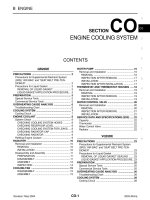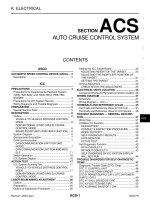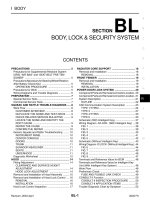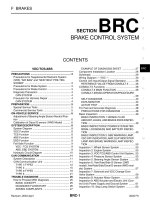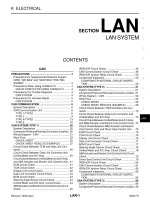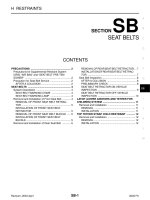HỆ THỐNG LÀM MÁT ĐỘNG CƠ TRÊN INFINITI FX35, FX45 2003
Bạn đang xem bản rút gọn của tài liệu. Xem và tải ngay bản đầy đủ của tài liệu tại đây (1.94 MB, 52 trang )
CO-1
ENGINE COOLING SYSTEM
B ENGINE
CONTENTS
C
D
E
F
G
H
I
J
K
L
M
SECTION CO
A
CO
Revision; 2004 April 2003 FX
ENGINE COOLING SYSTEM
VQ35DE
PRECAUTIONS 3
Precautions for Supplemental Restraint System
(SRS) “AIR BAG” and “SEAT BELT PRE-TEN-
SIONER” 3
Precautions for Liquid Gasket 3
REMOVAL OF LIQUID GASKET SEALING 3
LIQUID GASKET APPLICATION PROCEDURE 3
PREPARATION 5
Special Service Tools 5
Commercial Service Tools 6
OVERHEATING CAUSE ANALYSIS 7
Troubleshooting Chart 7
COOLING SYSTEM 9
Cooling Circuit 9
System Drawing 10
ENGINE COOLANT 11
Inspection 11
LEVEL CHECK 11
CHECKING COOLING SYSTEM FOR LEAKS 11
Changing Engine Coolant 11
DRAINING ENGINE COOLANT 11
REFILLING ENGINE COOLANT 12
FLUSHING COOLING SYSTEM 13
RADIATOR 14
Removal and Installation 14
REMOVAL 14
INSTALLATION 15
INSPECTION AFTER INSTALLATION 15
Checking Radiator Cap 15
Checking Radiator 16
Removal and Installation of Cooling Fan 16
REMOVAL 16
INSTALLATION 16
Disassembly and Assembly of Cooling Fan 16
DISASSEMBLY 16
ASSEMBLY 16
RADIATOR (ALUMINUM TYPE) 17
Disassembly and Assembly 17
PREPARATION 17
DISASSEMBLY 17
ASSEMBLY 18
INSPECTION 20
WATER PUMP 21
Removal and Installation 21
REMOVAL 21
INSPECTION AFTER REMOVAL 23
INSTALLATION 23
INSPECTION AFTER INSTALLATION 24
WATER INLET AND THERMOSTAT ASSEMBLY 25
Removal and Installation 25
REMOVAL 25
INSPECTION AFTER REMOVAL 26
INSTALLATION 26
INSPECTION AFTER INSTALLATION 26
WATER OUTLET AND WATER PIPING 27
Removal and Installation 27
REMOVAL 27
INSTALLATION 27
INSPECTION AFTER INSTALLATION 27
SERVICE DATA AND SPECIFICATIONS (SDS) 28
Standard and Limit 28
ENGINE COOLANT CAPACITY (APPROXI-
MATE) 28
THERMOSTAT 28
RADIATOR 28
VK45DE
PRECAUTIONS 29
Precautions for Supplemental Restraint System
(SRS) “AIR BAG” and “SEAT BELT PRE-TEN-
SIONER” 29
PREPARATION 30
Special Service Tools 30
Commercial Service Tools 30
CO-2
Revision; 2004 April 2003 FX
OVERHEATING CAUSE ANALYSIS 31
Troubleshooting Chart 31
COOLING SYSTEM 33
Cooling Circuit 33
System Drawing 34
ENGINE COOLANT 35
Inspection 35
LEVEL CHECK 35
CHECKING COOLING SYSTEM FOR LEAKS 35
Changing Engine Coolant 35
DRAINING ENGINE COOLANT 35
REFILLING ENGINE COOLANT 36
FLUSHING COOLING SYSTEM 37
RADIATOR 38
Removal and Installation 38
REMOVAL 38
INSTALLATION 40
INSPECTION AFTER INSTALLATION 40
Checking Radiator Cap 40
Checking Radiator 40
RADIATOR (ALUMINUM TYPE) 41
Disassembly and Assembly 41
PREPARATION 41
DISASSEMBLY 41
ASSEMBLY 42
INSPECTION 44
COOLING FAN 45
Removal and Installation (Crankshaft Driven Type) 45
REMOVAL 45
INSPECTION AFTER REMOVAL 45
INSTALLATION 45
INSPECTION AFTER INSTALLATION 45
Removal and Installation (Motor Driven Type) 46
REMOVAL 46
INSTALLATION 46
DISASSEMBLY AND ASSEMBLY 46
DISASSEMBLY 46
ASSEMBLY 46
WATER PUMP 47
Removal and Installation 47
REMOVAL 47
INSPECTION AFTER REMOVAL 47
INSTALLATION 48
INSPECTION AFTER INSTALLATION 48
THERMOSTAT AND WATER CONTROL VALVE 49
Removal and Installation 49
REMOVAL 49
INSPECTION AFTER REMOVAL 50
INSTALLATION 50
INSPECTION AFTER INSTALLATION 51
SERVICE DATA AND SPECIFICATIONS (SDS) 52
Standard and Limit 52
ENGINE COOLANT CAPACITY (APPROXI-
MATE) 52
THERMOSTAT 52
WATER CONTROL VALVE 52
RADIATOR 52
PRECAUTIONS
CO-3
[VQ35DE]
C
D
E
F
G
H
I
J
K
L
M
A
CO
Revision; 2004 April 2003 FX
[VQ35DE]
PRECAUTIONS PFP:00001
Precautions for Supplemental Restraint System (SRS) “AIR BAG” and “SEAT
BELT PRE-TENSIONER”
ABS00952
The Supplemental Restraint System such as “AIR BAG” and “SEAT BELT PRE-TENSIONER”, used along
with a front seat belt, helps to reduce the risk or severity of injury to the driver and front passenger for certain
types of collision. This system includes seat belt switch inputs and dual stage front air bag modules. The SRS
system uses the seat belt switches to determine the front air bag deployment, and may only deploy one front
air bag, depending on the severity of a collision and whether the front occupants are belted or unbelted.
Information necessary to service the system safely is included in the SRS and SB section of this Service Man-
ual.
WARNING:
● To avoid rendering the SRS inoperative, which could increase the risk of personal injury or death
in the event of a collision which would result in air bag inflation, all maintenance must be per-
formed by an authorized NISSAN/INFINITI dealer.
● Improper maintenance, including incorrect removal and installation of the SRS, can lead to per-
sonal injury caused by unintentional activation of the system. For removal of Spiral Cable and Air
Bag Module, see the SRS section.
● Do not use electrical test equipment on any circuit related to the SRS unless instructed to in this
Service Manual. SRS wiring harnesses can be identified by yellow and/or orange harnesses or
harness connectors.
Precautions for Liquid Gasket ABS005ZR
REMOVAL OF LIQUID GASKET SEALING
● After removing the mounting bolts and nuts, separate the mating
surface using a seal cutter (SST) and remove the old liquid gas-
ket sealing.
CAUTION:
Be careful not to damage the mating surfaces.
● Tap seal cutter to insert it, and then slide it by tapping on the
side as shown in the figure.
● In areas where seal cutter is difficult to use, use plastic hammer
to lightly tap the areas where the liquid gasket is applied.
CAUTION:
If for some unavoidable reason tool such as screwdriver is
used, be careful not to damage the mating surfaces.
LIQUID GASKET APPLICATION PROCEDURE
1. Using a scraper, remove the old liquid gasket adhering to the liq-
uid gasket application surface and the mating surface.
● Remove the liquid gasket completely from the groove of the
liquid gasket application surface, mounting bolts, and bolt
holes.
2. Wipe the liquid gasket application surface and the mating sur-
face with white gasoline (lighting and heating use) to remove
adhering moisture, grease and foreign materials.
PBIC0002E
PBIC0003E
CO-4
[VQ35DE]
PRECAUTIONS
Revision; 2004 April 2003 FX
3. Attach the liquid gasket tube to tube presser [SST: WS39930000
( – )].
Use Genuine RTV Silicone Sealant or equivalent. Refer to
GI-48, "
RECOMMENDED CHEMICAL PRODUCTS AND
SEALANTS" .
4. Apply the liquid gasket without breaks to the specified location
with the specified dimensions.
● If there is a groove for the liquid gasket application, apply the
liquid gasket to the groove.
● As for the bolt holes, normally apply the liquid gasket inside
the holes. Occasionally, it should be applied outside the
holes. Make sure to read the text of service manual.
● Within five minutes of liquid gasket application, install the mat-
ing component.
● If the liquid gasket protrudes, wipe it off immediately.
● Do not retighten mounting bolts and nuts after mounting bolts
and nuts the installation.
● After 30 minutes or more have passed from the installation, fill
engine oil and engine coolant.
CAUTION:
If there are specific instructions in this manual, observe them.
EMA0622D
SEM159F
PREPARATION
CO-5
[VQ35DE]
C
D
E
F
G
H
I
J
K
L
M
A
CO
Revision; 2004 April 2003 FX
PREPARATION PFP:00002
Special Service Tools ABS004T4
The actual shapes of Kent-Moore tools may from those of special service tools illustrated here.
Tool number
(Kent-Moore No.)
Tool name
Description
WS39930000
( – )
Tube presser
Pressing the tube of liquid gasket
KV10111100
(J-37228)
Seal cutter
Removing chain tensioner cover and water
pump cover
EG17650301
(J-33984-A)
Radiator cap tester adapter
Adapting radiator cap tester to radiator cap
and radiator filler neck
a: 28 (1.10) dia.
b: 31.4 (1.236) dia.
c: 41.3 (1.626) dia.
Unit: mm (in)
KV99103510
( – )
Radiator plate pliers A
Installing radiator upper and lower tanks
KV99103520
( – )
Radiator plate pliers B
Removing radiator upper and lower tanks
S-NT052
NT046
S-NT564
S-NT224
S-NT225
CO-6
[VQ35DE]
PREPARATION
Revision; 2004 April 2003 FX
Commercial Service Tools ABS004T5
Tool name Description
Power tool Loosening bolts and nuts
Radiator cap tester Checking radiator and radiator cap
PBIC0190E
PBIC1982E
OVERHEATING CAUSE ANALYSIS
CO-7
[VQ35DE]
C
D
E
F
G
H
I
J
K
L
M
A
CO
Revision; 2004 April 2003 FX
OVERHEATING CAUSE ANALYSIS PFP:00012
Troubleshooting Chart ABS004UZ
Symptom Check items
Cooling sys-
tem parts
malfunction
Poor heat transfer
Water pump malfunction Worn or loose drive belt
—
Thermostat stuck closed —
Damaged fins
Dust contamination or
paper clogging
Physical damage
Clogged radiator cooling
tube
Excess foreign material
(rust, dirt, sand, etc.)
Reduced air flow
Cooling fan does not oper-
ate
Fan assembly —High resistance to fan rota-
tion
Damaged fan blades
Damaged radiator shroud — — —
Improper engine coolant
mixture ratio
———
Poor engine coolant quality — Engine coolant density —
Insufficient engine coolant
Engine coolant leaks
Cooling hose
Loose clamp
Cracked hose
Water pump Poor sealing
Radiator cap
Loose
Poor sealing
Radiator
O-ring for damage, deterio-
ration or improper fitting
Cracked radiator tank
Cracked radiator core
Reservoir tank Cracked reservoir tank
Overflowing reservoir tank
Exhaust gas leaks into
cooling system
Cylinder head deterioration
Cylinder head gasket dete-
rioration
CO-8
[VQ35DE]
OVERHEATING CAUSE ANALYSIS
Revision; 2004 April 2003 FX
Except cool-
ing system
parts mal-
function
— Overload on engine
Abusive driving
High engine rpm under no
load
Driving in low gear for
extended time
Driving at extremely high
speed
Powertrain system mal-
function
—
Installed improper size
wheels and tires
Dragging brakes
Improper ignition timing
Blocked or restricted air
flow
Blocked bumper —
—
Blocked radiator grille
Installed car brassiere
Mud contamination or
paper clogging
Blocked radiator —
Blocked condenser
Blocked air flow
Installed large fog lamp
Symptom Check items
COOLING SYSTEM
CO-9
[VQ35DE]
C
D
E
F
G
H
I
J
K
L
M
A
CO
Revision; 2004 April 2003 FX
COOLING SYSTEM PFP:21020
Cooling Circuit ABS00AMN
PBIC2073E
CO-10
[VQ35DE]
COOLING SYSTEM
Revision; 2004 April 2003 FX
System Drawing ABS00AMO
PBIC0847E
ENGINE COOLANT
CO-11
[VQ35DE]
C
D
E
F
G
H
I
J
K
L
M
A
CO
Revision; 2004 April 2003 FX
ENGINE COOLANT PFP:KQ100
Inspection ABS00AMP
LEVEL CHECK
● Check if the reservoir tank engine coolant level is within the
“MIN” to “MAX” when engine is cool.
● Adjust the engine coolant level as necessary.
CHECKING COOLING SYSTEM FOR LEAKS
● To check for leaks, apply pressure to the cooling system with
radiator cap tester (commercial service tool) and radiator cap
tester adapter (SST).
WARNING:
Do not remove radiator cap when engine is hot. Serious
burns could occur from high-pressure engine coolant
escaping from radiator.
CAUTION:
Higher test pressure than specified may cause radiator
damage.
NOTE:
In a case that engine coolant decreases, replenish radiator with engine coolant.
● If anything is found, repair or replace damaged parts.
Changing Engine Coolant ABS00AMQ
WARNING:
● To avoid being scalded, never change engine coolant when engine is hot.
● Wrap a thick cloth around cap and carefully remove cap. First, turn cap a quarter of a turn to
release built-up pressure. Then turn cap all the way.
DRAINING ENGINE COOLANT
1. Remove front engine undercover with power tool.
2. Open radiator drain plug at the bottom of radiator, and remove
radiator cap.
CAUTION:
Be careful not to allow engine coolant to contact drive belts.
When drain all of engine coolant in the system, open water drain plugs on cylinder block. Refer to
EM-119, "
DISASSEMBLY" .
3. Check drained engine coolant for contaminants such as rust, corrosion or discoloration.
SMA412B
Testing pressure
: 157 kPa (1.6 kg/cm
2
, 23 psi)
SLC756A
SBIA0444E
CO-12
[VQ35DE]
ENGINE COOLANT
Revision; 2004 April 2003 FX
If contaminated, flush the engine cooling system. Refer to CO-13, "FLUSHING COOLING SYSTEM" .
4. Remove reservoir tank, drain engine coolant and clean reservoir tank before installing.
REFILLING ENGINE COOLANT
1. Install reservoir tank if removed, and radiator drain plug.
CAUTION:
Be sure to clean drain plug and install with new O-ring.
If water drain plugs are removed, close and tighten them. Refer to EM-124, "
ASSEMBLY" .
2. Remove air relief plug on heater hose.
3. Fill radiator and reservoir tank to specified level.
● Use Genuine Nissan Long Life Antifreeze/ Coolant or
equivalent mixed with water (distilled or demineralized).
Refer to MA-12, "
RECOMMENDED FLUIDS AND LUBRI-
CANTS".
● Pour engine coolant through engine coolant filler neck
slowly of less than 2 (2-1/8 US qt,1-3/4 lmp qt) a minute
to allow air in system to escape.
● When engine coolant overflows air relief hole on heater hose,
install air relief plug with new O-ring.
4. Warm up engine to normal operating temperature with radiator cap installed.
5. Run engine at 3,000 rpm for 10 seconds and return to idle speed.
● Repeat two or three times.
CAUTION:
Watch engine coolant temperature gauge so as not to overheat engine.
6. Stop engine and cool down to less than approximately 50°C (122°F).
● Cool down using a fan to reduce the time.
● If necessary, refill radiator up to filler neck with engine coolant.
7. Refill reservoir tank to “MAX” level line with engine coolant.
Radiator drain plug:
: 1.18 N·m (0.12 kg-m, 10 in-lb)
SBIA0445E
Engine coolant capacity
(with reservoir tank at “MAX” level)
: Approximately 8.6 (9-1/8 US qt, 7-5/8 lmp qt)
SMA182B
Reservoir tank engine coolant capacity (at “MAX” level)
: 0.8 (7/8 US qt, 3/4 lmp qt)
Air relief plug:
: 1.19 N·m (0.12 kg-m, 10 ft-lb)
SMA412B
ENGINE COOLANT
CO-13
[VQ35DE]
C
D
E
F
G
H
I
J
K
L
M
A
CO
Revision; 2004 April 2003 FX
8. Repeat steps 3 through 6 two or more times with radiator cap installed until engine coolant level no longer
drops.
9. Check cooling system for leaks with engine running.
10. Warm up engine, and check for sound of engine coolant flow while running engine from idle up to 3,000
rpm with heater temperature controller set at several position between “COOL” and “WARM”.
● Sound may be noticeable at heater unit.
11. Repeat step 10 three times.
12. If sound is heard, bleed air from cooling system by repeating step 3 through 6 until engine coolant level no
longer drops.
● Clean excess engine coolant from engine.
FLUSHING COOLING SYSTEM
1. Fill radiator with water until water spills from the air relief hole, then close air relief plug. Fill radiator and
reservoir tank with water and reinstall radiator cap.
2. Run engine and warm it up to normal operating temperature.
3. Rev engine two or three times under no-load.
4. Stop engine and wait until it cools down.
5. Drain water from the system. Refer to CO-11, "
DRAINING ENGINE COOLANT" .
6. Repeat steps 1 through 5 until clear water begins to drain from radiator.
CO-14
[VQ35DE]
RADIATOR
Revision; 2004 April 2003 FX
RADIATOR PFP:21400
Removal and Installation ABS00AMR
WARNING:
Never remove radiator cap when engine is hot. Serious burns could occur from high-pressure engine
coolant escaping from radiator.
REMOVAL
1. Remove front engine undercover with power tool.
2. Drain engine coolant from radiator. Refer to CO-11, "
Changing Engine Coolant" .
CAUTION:
Perform when engine is cold.
3. Remove air duct and air cleaner case assembly. Refer to EM-17, "
AIR CLEANER AND AIR DUCT" .
4. Remove reservoir tank and reservoir tank bracket.
5. Disconnect A/T fluid cooler hoses from radiator.
● Install blind plug to avoid leakage of A/T fluid.
6. Disconnect radiator upper and lower hoses from radiator.
7. Remove radiator cooling fan assembly. Refer to CO-16, "
Removal and Installation of Cooling Fan" .
1. Radiator 2. Radiator upper mount bracket 3. Mounting rubber (upper)
4. Radiator cap 5. Mounting rubber (lower) 6. O-ring
7. Drain plug 8. Clamp (radiator hose) 9. Radiator hose (lower)
10. Radiator hose (upper) 11. Clamp (A/T fluid cooler hose) 12. A/T fluid cooler hose
13. Clamp (reservoir tank hose) 14. Reservoir tank hose 15. Reservoir tank cap
16. Reservoir tank 17. Reservoir tank bracket 18. Radiator cooling fan assembly
SBIA0446E
RADIATOR
CO-15
[VQ35DE]
C
D
E
F
G
H
I
J
K
L
M
A
CO
Revision; 2004 April 2003 FX
8. Rotate two radiator upper mount brackets 90 degrees in the
direction shown in the figure, and remove them.
9. Lift up and remove radiator.
CAUTION:
Do not damage or scratch air conditioner condenser and
radiator core when removing.
INSTALLATION
Install in the reverse order of removal.
INSPECTION AFTER INSTALLATION
● Check for leaks of engine coolant using radiator cap tester adapter [SST: EG17650301 (J-33984-A)] and
radiator cap tester (commercial service tool). Refer to CO-11, "
CHECKING COOLING SYSTEM FOR
LEAKS" .
● Start and warm up engine. Visually make sure that there is no leaks of engine coolant and A/T fluid.
Checking Radiator Cap ABS00AMS
1. Pull radiator cap negative-pressure valve to open it, and make
sure it close completely when released.
● Make sure there is no dirt or damage on valve seat of radiator
cap negative-pressure valve.
● Make sure there are no unusualness in the opening and clos-
ing conditions of radiator cap negative-pressure valve.
2. Check radiator cap relief pressure.
● When connecting radiator cap to radiator cap tester adapter
(SST) and radiator cap tester (commercial service tool), apply
engine coolant to the cap seal part.
● Replace radiator cap if there is an unusualness in radiator cap
negative-pressure valve, or if the open-valve pressure is out-
side of the standard values.
SBIA0447E
SBIA0448E
SMA967B
Standard
: 78 - 98 kPa (0.8 - 1.0 kg/cm
2
, 11 - 14 psi)
Limit
: 59 kPa (0.6 kg/cm
2
, 9 psi)
SLC755A
CO-16
[VQ35DE]
RADIATOR
Revision; 2004 April 2003 FX
Checking Radiator ABS00AMT
Check radiator for mud or clogging. If necessary, clean radiator as follows.
● Be careful not to bend or damage radiator fins.
● When radiator is cleaned without removal, remove all surrounding parts such as cooling fan shroud and
horns. Then tape harness and connectors to prevent water from entering.
1. Apply water by hose to the back side of the radiator core vertically downward.
2. Apply water again to all radiator core surfaces once per minute.
3. Stop washing if any stains no longer flow out from radiator.
4. Blow air into the back side of radiator core vertically downward.
● Use compressed air lower than 490 kPa (5 kg/cm
2
, 71 psi) and keep distance more than 30 cm (11.8
in).
5. Blow air again into all the radiator core surfaces once per minute until no water sprays out.
Removal and Installation of Cooling Fan ABS00D9M
REMOVAL
1. Remove air duct (inlet), power duct and air cleaner case assembly. Refer to EM-17, "AIR CLEANER AND
AIR DUCT" .
2. Disconnect fan motor connectors.
3. Remove radiator cooling fan assembly.
CAUTION:
Be careful not to damage or scratch on radiator core.
INSTALLATION
Note to the following, and install in the reverse order of removal.
● Cooling fan is controlled by ECM. For details, refer to EC-480, "DTC P1217 ENGINE OVER TEMPERA-
TURE" .
Disassembly and Assembly of Cooling Fan ABS00D9N
DISASSEMBLY
1. Remove fans from fan motors.
2. Remove fan motors from fan shroud.
ASSEMBLY
Install in the reverse order of disassembly.
1. Cooling fan 2. Fan shroud 3. Fan motor
SBIA0594E
RADIATOR (ALUMINUM TYPE)
CO-17
[VQ35DE]
C
D
E
F
G
H
I
J
K
L
M
A
CO
Revision; 2004 April 2003 FX
RADIATOR (ALUMINUM TYPE) PFP:21460
Disassembly and Assembly ABS00AMU
PREPARATION
1. Attach spacer to the tip of radiator plate pliers A (SST).
Spacer specification: 1.5 mm (0.059 in) thick x 18 mm (0.71 in)
wide x 8.5 mm (0.335 in) long.
2. Make sure that when radiator plate pliers A (SST) are closed
dimension H′′ is approx. 7.6 mm (0.299 in).
3. Adjust dimension H′′ with spacer, if necessary.
DISASSEMBLY
1. Remove upper or lower tanks with radiator plate pliers B (SST).
1. Upper tank 2. Sealing rubber 3. Core
4. Lower tank 5. Conical washer 6. Washer
7. O-ring 8. A/T fluid cooler
SBIA0449E
SLC655CB
SLC903-A
CO-18
[VQ35DE]
RADIATOR (ALUMINUM TYPE)
Revision; 2004 April 2003 FX
● Grip the crimped edge and bend it upwards so that radiator
plate pliers B slips off.
Do not bend excessively.
● In areas where radiator plate pliers B cannot be used, use a
screwdriver to bend the edge up.
Be careful not to damage tank.
2. Remove sealing rubber.
3. Make sure the edge stands straight up.
4. Remove A/T fluid cooler from lower tank.
ASSEMBLY
1. Install A/T fluid cooler.
Pay attention to direction of conical washer.
SLC893
SLC930
SLC931
SBIA0577E
RADIATOR (ALUMINUM TYPE)
CO-19
[VQ35DE]
C
D
E
F
G
H
I
J
K
L
M
A
CO
Revision; 2004 April 2003 FX
2. Clean contact portion of tank.
3. Install sealing rubber.
Push it in with fingers.
Be careful not to twist sealing rubber.
4. Caulk tank in specified sequence with radiator plate pliers A
(SST).
SLC932
SLC917A
SLC904-A
SLC896
CO-20
[VQ35DE]
RADIATOR (ALUMINUM TYPE)
Revision; 2004 April 2003 FX
● Use pliers in the locations where plate pliers A cannot be
used.
5. Make sure that the rim is completely crimped down.
6. Confirm that there is no leakage.
Refer to CO-20, "
INSPECTION" .
INSPECTION
1. Apply pressure with radiator cap tester adapter (SST) and radia-
tor cap tester (commercial service tool).
WARNING:
To prevent the risk of the hose coming undone while under
pressure, securely fasten it down with a hose clamp.
CAUTION:
Attach a hose to A/T fluid cooler to seal its inlet and outlet.
2. Check for leakage by soaking radiator in water container with
the testing pressure applied.
SLC897
Standard height “H” : 8.0 - 8.4 mm (0.315 - 0.331 in)
SLC554A
Testing pressure
: 157 kPa (1.6 kg/cm
2
, 23 psi)
SLC933-A
SLC934
WATER PUMP
CO-21
[VQ35DE]
C
D
E
F
G
H
I
J
K
L
M
A
CO
Revision; 2004 April 2003 FX
WATER PUMP PFP:21020
Removal and Installation ABS00AMX
CAUTION:
● When removing water pump, be careful not to get engine coolant on drive belt.
● Water pump cannot be disassembled and should be replaced as a unit.
REMOVAL
1. Remove front engine undercover with power tool.
2. Remove drive belts. Refer to EM-15, "
DRIVE BELTS" .
3. Drain engine coolant from radiator. Refer to CO-11, "
Changing Engine Coolant" .
CAUTION:
Perform when engine is cold.
4. Remove air duct (inlet), power duct and air cleaner case assembly. Refer to EM-17, "
AIR CLEANER AND
AIR DUCT" .
5. Remove water drain plug (front) of cylinder block.
6. Remove chain tensioner cover and water pump cover separat-
ing the mating surface with a seal cutter [SST: KV10111100 (J-
37228)].
CAUTION:
Be careful not to damage the mating surfaces.
1. Chain tensioner 2. Chain tensioner cover 3. Water pump cover
4. Water pump 5. O-rings 6. Water drain plug (front)
SBIA0482E
PBIC0846E
CO-22
[VQ35DE]
WATER PUMP
Revision; 2004 April 2003 FX
7. Remove timing chain tensioner (primary) with the following pro-
cedure.
a. Pull the lever down and release plunger stopper tab.
● Plunger stopper tab can be pushed up to release (coaxial
structure with lever).
b. Insert stopper pin into the tensioner body hole to hold lever and
keep the plunger stopper tab released.
NOTE:
An Allen wrench [2.5 mm (0.098 in)] is used for a stopper pin as
an example.
c. Insert plunger into the tensioner body by pressing timing chain
slack guide.
d. Keep slack guide pressed and hold plunger in by pushing stopper pin deeper through lever and into the
tensioner body hole.
e. Turn crankshaft pulley approximately 20° clockwise so that tim-
ing chain on the timing chain tensioner (primary) side is loose.
f. Remove mounting bolts and timing chain tensioner (primary).
CAUTION:
Be careful not to drop mounting bolts inside chain case.
8. Remove three water pump fixing bolts. Secure a gap between
water pump gear and timing chain, by turning crankshaft pulley
counterclockwise until timing chain looseness on water pump
sprocket becomes maximum.
PBIC2112E
PBIC0848E
PBIC2113E
PBIC1193E
WATER PUMP
CO-23
[VQ35DE]
C
D
E
F
G
H
I
J
K
L
M
A
CO
Revision; 2004 April 2003 FX
9. Screw M8 bolts [pitch: 1.25 mm (0.049 in) length: approx. 50
mm (1.97 in)] into water pumps upper and lower mounting bolt
holes until they reach timing chain case. Then, alternately
tighten each bolt for a half turn, and pull out water pump.
CAUTION:
● Pull straight out while preventing vane from contacting
socket in installation area.
● Remove water pump without causing sprocket to contact
timing chain.
10. Remove M8 bolts and O-rings from water pump.
CAUTION:
Do not disassembly water pump.
INSPECTION AFTER REMOVAL
● Check for badly rusted or corroded water pump body assembly.
● Check for rough operation due to excessive end play.
● If anything is found, replace water pump.
INSTALLATION
1. Install new O-rings to water pump.
● Apply engine oil and engine coolant to O-rings as shown in
the figure.
● Locate O-ring with white paint mark to engine front side.
2. Install water pump.
CAUTION:
Do not allow cylinder block to nip O-rings when install
water pump.
● Make sure timing chain and water pump sprocket are
engaged.
● Insert water pump by tightening mounting bolts alternately
and evenly.
3. Install timing chain tensioner (primary) as the following:
a. Remove dust and foreign material completely from backside of chain tensioner and from installation area
of rear timing chain case.
b. Turn crankshaft pulley clockwise so that timing chain on the timing chain tensioner (primary) side is loose.
● Apply engine oil should be applied to the oil hole and tensioner, when installing timing chain
tensioner.
JLC357B
SLC943A
PBIC1397E
PBIC1058E
CO-24
[VQ35DE]
WATER PUMP
Revision; 2004 April 2003 FX
c. Install timing chain tensioner (primary).
d. Remove stopper pin.
4. Install chain tensioner cover and water pump cover.
a. Before installing, remove all traces of liquid gasket from mating
surface of water pump cover and chain tensioner cover using a
scraper. Also remove traces of liquid gasket from the mating sur-
face of front timing chain case.
b. Apply a continuous bead of liquid gasket to mating surface of
chain tensioner cover and water pump cover with tube presser
[SST: WS39930000 ( – )].
Use Genuine RTV Silicone Sealant or equivalent. GI-48,
"RECOMMENDED CHEMICAL PRODUCTS AND SEAL-
ANTS".
5. Install water drain plug (front) of cylinder block.
● Apply liquid gasket to the thread of water drain plug (front).
Use Genuine RTV Silicone Sealant or equivalent. Refer to GI-48, "
RECOMMENDED CHEMICAL
PRODUCTS AND SEALANTS".
6. Install in the reverse order of removal for remaining parts.
● After starting engine, let idle for three minutes, then rev engine up to 3,000 rpm under no load to
purge air from the high-pressure chamber of chain tensioner. Engine may produce a rattling
noise. This indicates that air still remains in the chamber and is not a matter of concern.
INSPECTION AFTER INSTALLATION
● Check for leaks of engine coolant using radiator cap tester adapter [SST: EG17650301 (J-33984-A)] and
radiator cap tester (commercial service tool). Refer to CO-11, "
CHECKING COOLING SYSTEM FOR
LEAKS" .
● Start and warm up engine. Visually make sure that there is no leaks of engine coolant and A/T fluid.
SLC448B
SLC446B
PBIC1283E
WATER INLET AND THERMOSTAT ASSEMBLY
CO-25
[VQ35DE]
C
D
E
F
G
H
I
J
K
L
M
A
CO
Revision; 2004 April 2003 FX
WATER INLET AND THERMOSTAT ASSEMBLY PFP:21200
Removal and Installation ABS00AMY
REMOVAL
1. Remove front engine undercover using power tool.
2. Drain engine coolant from radiator. Refer to CO-11, "
Changing Engine Coolant" .
CAUTION:
● Perform this step when engine is cold.
● Do not spill engine coolant on drive belts.
3. Remove air duct and air cleaner case. Refer to EM-17, "
AIR CLEANER AND AIR DUCT" .
4. Remove water drain plug (front) of cylinder block.
5. Disconnect radiator hose (upper) and oil cooler hose from water inlet and thermostat assembly.
6. Remove water inlet and thermostat assembly.
● Do not disassemble water inlet and thermostat assembly.
Replace them as a unit, if necessary.
1. Water inlet and thermostat assembly 2. Gasket
SBIA0483E
PBIC0846E
SLC962AB
